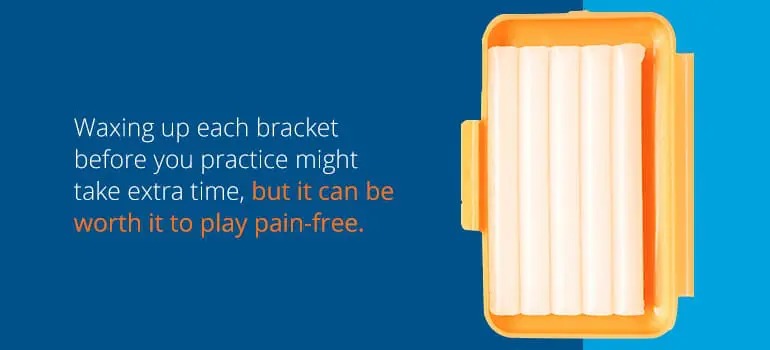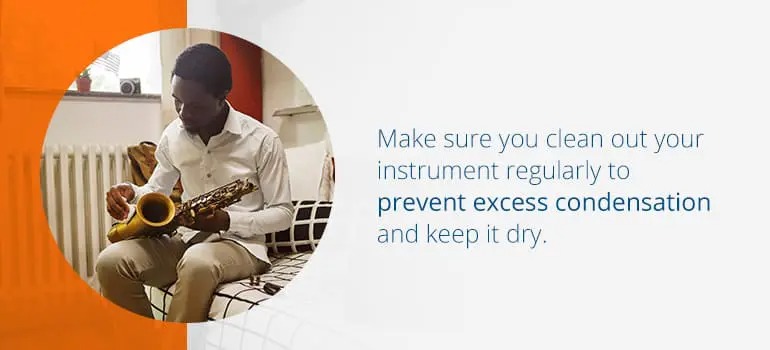
The promise of the healthy and straight smile that comes with braces can make getting them a very exciting event. However, there are a couple of adjustments you’ll have to make while wearing braces to achieve that beautiful smile. For those with a passion for a wind instrument, the biggest question is usually “Can I play with braces?”
Many kids and adults have worked hard to achieve a certain level of playing, so the thought of giving up their instrument may seem undesirable. And as a way to relieve stress, build confidence, improve memory, and more, playing an instrument can be an indispensable part of a people’s lives. Luckily, there’s no need to quit playing once you get braces.
This article will explain how braces can affect different musicians’ ability to play, give some tips for playing musical instruments with braces, and discuss taking care of your instrument and braces. Keep reading to find out how braces and playing the trumpet — or any other instrument — can get along seamlessly.
In general, braces should not keep you from playing any musical instrument, though wind instrument players may find that braces affect their ability to play the way they are used to. Some types of wind instruments may be more challenging than others when you have braces. Woodwinds, such as the clarinet and saxophone, tend to be easier to play with braces. Brass instruments, such as the trumpet or the French horn, are a bit more difficult.
There will be an adjustment period when you get your braces put on and when they are taken off. But with practice, perseverance, and a positive attitude, you will still be able to master your musical instrument. Braces are a big change, so you will need to be patient and realistic. Keep in mind that many others have succeeded in playing an instrument with braces before you, so it is possible.
If you stick it out and continue to play while having braces, research shows you may end up playing with more embouchure comfort and with better skill than before. Retraining yourself to play with braces gives you the unique opportunity to correct bad habits, such as pinching to get notes out or applying too much pressure to play. Through learning how to adapt to playing with braces and using more air to play, you may end up growing as a musician.
If you’re struggling to adjust to playing your instrument with braces, try following these fourtips:
Although practicing is the key to getting more comfortable with playing your instrument with braces, it is important that you don’t over practice and burn yourself out. Try to practice for fairly short amounts of time at first — around 15 minutes to 20 minutes — and stop practicing if you start to feel tired or stressed. Because your practices will be shorter, practice multiple times per day.
Keep in mind that the first few times you attempt to practice with braces may be uncomfortable or discouraging, but you will get better with time. The calluses on the inside of your lips will build up as you practice more, and once they are there, playing will no longer cause as much discomfort. Make sure you rest as much as you practice so you don’t overdo it and set yourself back.

If you are playing a brass or woodwind instrument with braces, orthodontic wax may be your new best friend. Ask your dentist or orthodontist to give you extra wax to put over the spots on your braces that press against your lips the most when you play. This can protect the inside of your lips from irritation and sores. Waxing up each bracket before you practice might take extra time, but it can be worth it to play pain-free.
Aside from wax, there are other appliances that may assist you while playing your instrument with braces. Some musicians with braces have preferred to use a sort of mouth guard or pad to play. Talk with your dentist before attempting to create a homemade barrier for your braces.
While wax and other appliances can help some people play without pain, others rely more on loosening their embouchure — the way they apply their mouth to their instrument’s mouthpiece — and reducing the pressure necessary to play. To begin adjusting your embouchure, try playing long, low tones at soft volumes until you find a spot that sounds good and feels comfortable. Work your way up to higher notes, slowly, slurring as you go. After some practice, you can redevelop your muscle memory and retrain your embouchure.
Sometimes switching to a mouthpiece with a wider rim can give your lips more cushion and make playing feel better. Ask your music teacher for advice when trying to decide on a new mouthpiece. By working closely with your music teacher, you can also start developing good habits that will benefit you long after you get your braces off.
It’s common for musicians to feel they need to use more breath to play their instruments while they have braces. This often affects woodwind musicians because clamping down on the mouthpiece may be more difficult with braces than it had been before. Be prepared to make the adjustment of using more breath to play your instrument while knowing it can ultimately make you a more well-rounded musician.

Sounding your best while wearing braces means keeping both your instrument and braces clean. Because braces can increase the amount of saliva in your mouth when you play, watch out for condensation buildup in your instrument. Too much condensation can cause an instrument to gurgle or alter its overall sound quality, particularly for instruments like the saxophone and flute. Make sure you clean out your instrument regularly to prevent excess condensation and keep it dry. Making a habit of cleaning your instrument before and after you play can ensure it remains in its best shape.
In the same way, you will need to respect and care for your braces to keep them in good condition. Be meticulous about brushing your teeth twice per day, as well as after each meal. Flossing on a daily basis and refraining from hard foods and candies that could break your brackets can get you one step closer to the straight smile you’ve been dreaming of.
Every musical instrument is different, and everyone’s experience with braces is different. For dental advice about your specific situation, contact AZ Family Dental to discuss how you can be the best musician you can be while wearing braces. At AZ Family Dental, we’re equipped to review all your orthodontic options, including clear aligners, which many wind instrument players tend to prefer.
If you’re a musician in Glendale, AZ, looking for modern dentistry done right, call 623-777-3091 today.